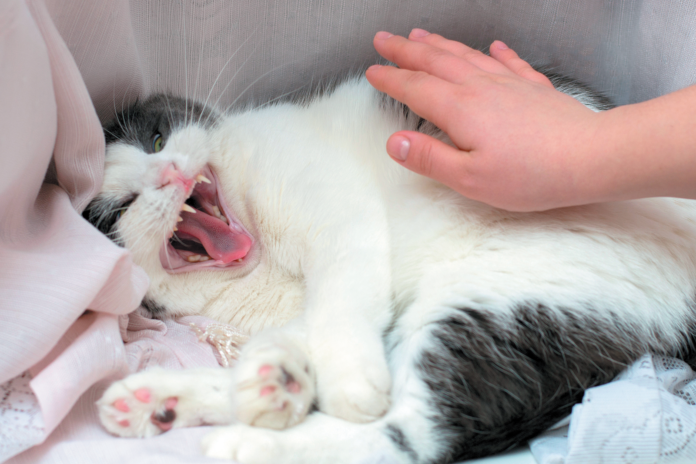It has been posited that kittens taken from their mothers too soon and need to be bottle fed are more likely to turn out aggressive, as are cats who are singletons or end up in shelters without their littermates. But new research shows that the way owners treat their cats after adoption is much more predictive of feline aggression than earlier influences. The silver lining: if your cat is aggressive and apt to scratch or otherwise lash out at you, it may be about your own behavior, which is something you can modify to improve the situation.
Researchers at the University of Guelph’s Ontario Veterinary College made the finding about aggression in cats when they surveyed some 260 owners of cats between the ages of 1 and 6. The odds of owner-directed aggression were higher in cats subjected to punishment when they acted in ways their human “parents” did not want and lower in cats who were rewarded for good behavior rather than punished for bad. The findings are particularly significant in light of the fact that aggression was not a rare occurrence. More than one in three cats acted in combative ways, biting and swatting at people.
The punishment inflicted on a cat that appears to result in aggression does not have to be just physical, such as hitting a cat or holding it by the scruff of the neck (neither of which a cat owner should do). It can also be verbal. Simply yelling at a cat is a type of punishment and causes a great deal of feline stress. Remember, cats do not behave in ways you don’t want to get your goat. They behave in ways you don’t want because they’re cats. They don’t know that the fabric they’re scratching on the couch costs $200 a yard, or that it’s not sanitary to walk all over the kitchen counter, or that you don’t want them lying among the warm, fluffy towels in the linen closet that you’ve just washed and dried. They simply have an instinctive urge to scratch, stroll around in high-up places, and snuggle in cozy spots.
Steps to keep aggression from developing
The researchers conducting the study point out that they only found a correlation between punishment and aggressive behavior in cats — not proof of cause and effect. In other words, it may be that people who punish their cats by yelling or with even more harmful tactics do so because their cats are already aggressive. But no cat owner should be inflicting punishment on a cat for any reason in the first place. That only frays the bond between person and feline and has the potential to make a pet cat scared and miserable and yes, perhaps more apt to lash out. A much better scenario for setting up a good relationship with your cat and for minimizing the risk of feline aggression is to set up an environment that will let your cat be a cat without fraying your nerves. To that end:
- Make sure your cat has scratching posts to drag her nails along in order to satisfy her natural urge. And instead of yelling at her when she scratches in the wrong place, reward her for scratching in the right ones. When she uses one of her scratching posts, immediately give her warm praise and a treat. It’s easy to remember to scold a pet for doing something wrong but to forget to make her feel good for getting it right. The more she’s rewarded for getting it right, the more she’ll want to get it right in the future.
- Provide high places for your pet to perch. And don’t make your kitchen counter more alluring by leaving out food or food crumbs.
- Make sure your cat has hidey holes, snug boxes, and other tight spots to curl up in so that she’s less apt to create a hidey hole in a place that you would prefer to be off limits.
These are all forms of environmental enrichment, which the researchers also found is correlated with a lower risk of feline aggression.
Positive training counts, too
Another way to help your cat behave agreeably rather than aggressively toward you is to engage her in learning tricks. Contrary to popular belief, cats are interested in cooperative play — if there’s something in it for them. You can teach your cat to come over to you and learn other behaviors by immediately rewarding her with a delicious food treat and enthusiastic praise when she follows through on your cue.
It’s best to train your cat in very short sessions — a couple of minutes here and there. Felines are not built to stay with it longer. In addition, go slowly and gradually. If you try to teach your pet to do too much too fast, she’s going to become frustrated and will probably not want to keep playing with you. Better to break up a trick into two or three tricks. The little successes will build your cat’s confidence — and her trust that you’re not trying to wear her out — and make her more apt to want to keep learning from you in exchange for food and verbal rewards. It will also make her more inclined to comply when you tell her “Off” as she jumps to the kitchen counter. She will know that if she listens to you, good things will follow because you will have established a trusting bond.
Even yelling in the house that’s not directed at your cat can cause her considerable stress and conceivably make her more apt to act out. Try to keep your voice calm and steady, even if you’re engaged in an argument to which your cat is a spectator rather than a participant.





i have an aggressive feral cat who has been coming here for months…. he is always there!! i set up a box with heating pad to keep him warm and feed him twice a day….. YET HE IS STILL AGGRESSIVE WITH ME, SWATS AT ME DURING THE GLASS DOOR, HE DOES NOT WANT TO COME IN….. YET HE IS ALWAYS THERE!!! WHY?????
If the cat is feral, meaning it truly was born outside and raised in a feral cat colony, it is probably just terrified of you, since it wasn’t raised by humans and didn’t interact with them in it’s kitten months when you can sometimes ‘domesticate’ feral cats. Sometimes feral cats, after being given their own time, which is often very long in human minds – think months to years – will adapt to being around humans but they typically never progress to being your standard old house cat. They usually won’t jump up on laps and cuddle and most don’t want to be handled at all. Some will never even make it into the house with you but they def find something they need – shelter, food, etc. – at your house and are just trying to defend themselves since they didn’t grow up with humans . RCK, DVM